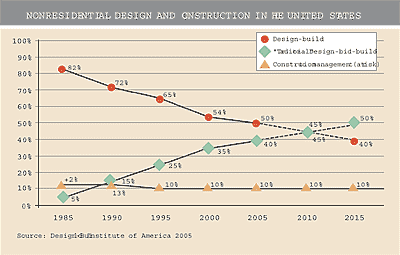The Hopes and Fears of Design-Build
Risk: architecture's bogeyman
One of the biggest fears architects have about leading a design-build project is the increased risk associated with construction. While the tasks traditionally associated with architecture are insurable, work occurring on a construction site is not. There is, however, a huge opportunity for architects who take that risk because, explains Buchanan, the profit on the construction fee will be six to 10 times greater per dollar volume than that on the architectural fee. Risk, therefore, is not managed by insurance but by significantly higher profits that can be used to correct any defective work that may occur in the field.
For Buchanan, there are scenarios in design-bid-build that are much riskier: "The only time I have ever had a threat of legal action was when I was the architect for a project that was being built by a general contractor who wasn't qualified-now, that is scary."
|
In contrast, Buchanan feels that he is in the best position to come up with the best solutions when problems do arise because he knows his designs so well and because there is only one company involved. "If there is a problem in the field, it's our problem. There is not this do-si-do where everyone gets into a defensive mode-making sure the blame lies elsewhere-but no one is looking for a solution. We go into ‘fix-the-problem' mode right away, because that's what the client wants."
Buchanan also believes there are additional safeguards inherent to running a firm with both design and construction services: During the inevitable vagaries of business cycles, one side is often able to keep the other side afloat.
One method doesn't suit all
Supporters of design-build do not suggest that every project must be done according to this method of delivery. Quatman indicates that design-build is most useful when a project is driven by cost and schedule. And Hellmuth believes that it is best suited to a project whose program is well defined from the start by the client. Nor do they believe every architect has the personality to lead a design-build project. "The world of construction is urgent and in your face, and things don't go as planned. It's not for someone who prefers to have all his or her ducks in a row months ahead of time," warns Buchanan.
But for those interested in getting started in some capacity, there are a host of resources available. Quatman's own book, Design Build for the Design Professional, published by Aspen Law & Business, offers an encyclopedic reference for virtually all aspects of this delivery method, including chapters on insurance, bonding, and contracts. Practitioners are encouraged to attend seminars hosted by AIA and DBIA on the subject. And, perhaps the most common piece of advice given on this topic, architects should begin networking with builders that they know and trust.









